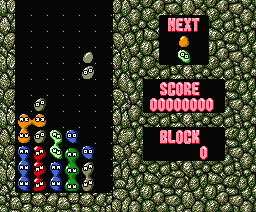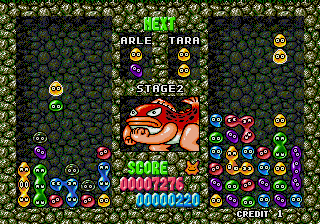
|
|
|
|
|
|
|
Title (USA) Dr. Robotnik's Mean Bean Machine Title (Europe) Dr. Robotnik's Mean Bean Machine Developer Compile Sega of America Platform Sega Mega Drive Format 4M cartridge Genre Puzzle |
|
|
|
USA November, 1993 Europe November, 1993 |
|
|
|
Producers Yoji Ishii Noriyoshi Ohba Moo Niitani Directors Tetsuo Shinyu Takayuki Yanagihori M. Tsukamoto Graphic Designers Takaya Segawa Saori Yamaguchi Hideaki Moriya Keisuke Saka Programmers Manabu Ishihara Tsukasa Aoki Music & SFX Masanori Hikichi Masayuki Nagao
Max Taylor Designers Max Taylor Brian Ransom Dave Albert Sound David Javelosa |
|
|
|
Sega Mega Drive Dr. Robotnik's Mean Bean Machine Sonic Compilation Nintendo GameCube Sonic Mega Collection Sony PlayStation 2 Sonic Mega Collection Plus Microsoft Xbox Sonic Mega Collection Plus Microsoft Xbox 360 Sonic's Ultimate Genesis Collection Sony PlayStation 3 Sonic's Ultimate Genesis Collection Nintendo Wii Virtual Console
Windows PC |
|
Last update: 12/15/06
:: Quick Jump ::
Colored Beans (Puyos) fall in pairs from the top of the screen. You can control their descent with the D-pad and rotate their formation with the action buttons. The object is to match colored sets of Beans into groups of four. When four Beans of a like color connect, they disappear from the playfield, causing all the Beans stacked on top to drop a level which can cause chain reactions for big points. The Beans come in 5 different colors: red, yellow, green, purple, and blue (though you won't have to deal with blue ones until the mid levels) and fall progressively faster as you work your way up. The drop rate will occasionally increase even in the early stages, but these bursts are only temporary. Scenario Mode (Hitori de Puyo Puyo) is the basic 1-player arcade mode. The goal here is to work your way through a series of 13 increasingly difficult opponents. Both you and your rival have a pit for falling Beans, and the first to let theirs get filled to the top loses. In the early stages, it's possible to win by simply playing on the defensive and making sure your pit stays as empty as possible. As your opponents become increasingly sneaky, however, you need to strategically stack your Beans so as to cause chain reactions, which send Refugees (Ojama) cascading into your rival's bin. Refugees are transparent beans dumped at random to muddle the plans of their unfortunate recipient. They can't be connected like normal Beans and can only be eliminated by having them touch a cluster of disappearing colored Beans. The amount of Refugees dumped depends on the length of the combo that created them, hence the importance of planning large chain reactions. Scenario Mode consists of 13 opponents, all pulled from DiC's low-budget "The Adventures of Sonic the Hedgehog" cartoon show: Arms, Frankly, Humpty, Coconuts, Davy Sprocket, Skweel, Dynamight, Grounder, Spike, Sir Ffuzzy-Logik, Dragon Breath, Scratch, and of course Dr. Robotnik himself. (Though all of these characters appeared at some point or other during the cartoon's run, only Coconuts, Grounder, Scratch, and Robotnik were regular cast. Coconuts and Grounder are loosely based on Sonic 2's Ai-ai and Handrill enemies, called "Coconuts" and "Grounder" in the English manuals.) Each opponent will take a moment to indulge in some trash talk before the round begins and it is foul punnery of the lowest denomination which you can thankfully skip through.
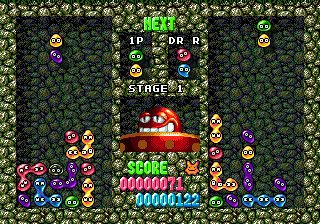
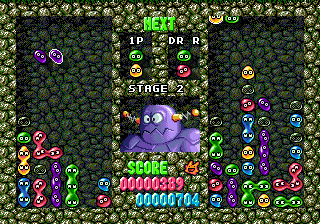
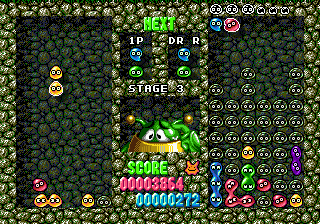
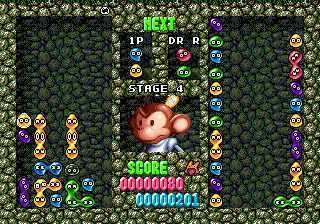
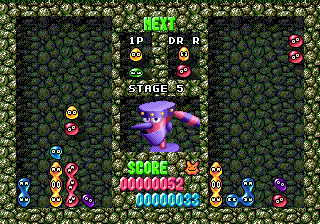
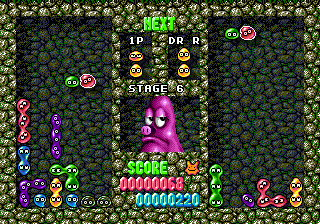
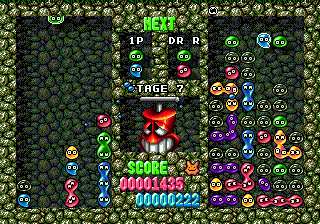
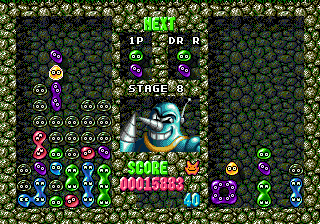
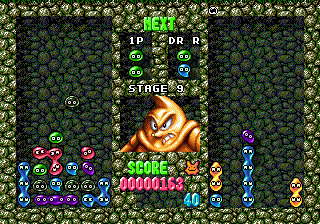
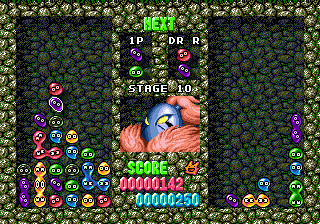
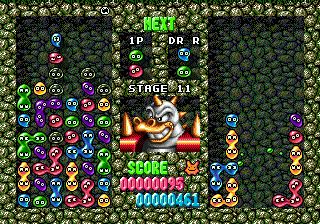
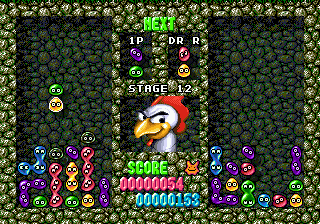
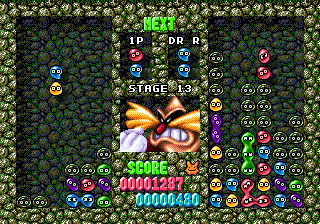 In addition to the 1-player Scenario Mode, there's a 1P vs. 2P Mode (Futari de Puyo Puyo) and an Excercise Mode (Tokoton Puyo Puyo). Excercise mode is a low-pressure 1-player game with no opponents. The only object is to last for as long as you can while racking up a high score. If you've been performing fairly well, but your situation has nonetheless turned bleak, you may be blessed with a visit from Big Bean (Big Puyo) or Has Bean (Carbuncle, the Puyo Puyo mascot). Big Bean falls through the bottom of the screen in a straight vertical line, eliminating the two rows of beans that stand in his way. He should be used cautiously, because if the fat green turd cuts through any potential chains, he'll do more damage than good. The more frolicksome Has Bean trots in a random, winding pattern through your crowded bin, converting all of the Beans he touches to one color. (Big Bean and Has Bean do not appear in Scenario or versus modes.) In the Options menu, you can adjust the default button layout, choose the computer difficulty level (easy, normal, hard, or hardest), set the 2-player match count (1, 3, 5, 7, 9, 11, 13, or 15), toggle the "sampling" on or off (refers to certain sound effects), or mess with the input test to make sure all the buttons on your controller are in working order.
In addition to the obvious cosmetic changes, Mean Bean Machine also introduces a password feature which is not present in the original Japanese Puyo. (The original version actually allows you to start from stage 1 or 4, and also includes a 3-stage training mode.) The silly banter of the Madou cast that precedes each round, while not exactly high entertainment, is still a cut above the awful smack talk of Robotnik's cronies. Other than some narrative devolution, however, the two games are basically identical. Here are some screenshots from the Japanese Mega Drive version:
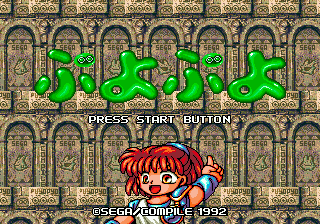
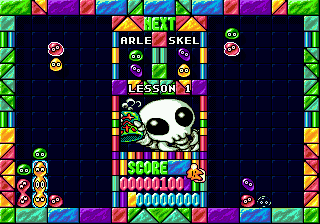
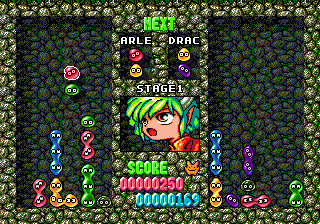
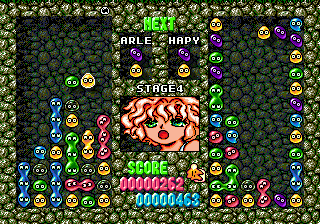
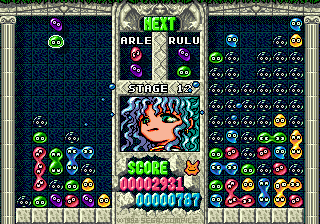
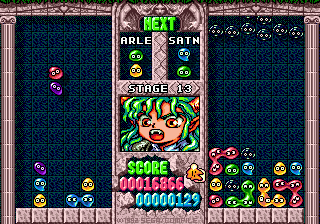 Compile, incidentally, filed bankruptcy in 2002, after which Sega gained total ownership of the Puyo franchise. Sonic Team's Puyo Puyo Fever became the first title released under the new regime.
Written content and original graphics copyright © 1997-2007 Jared Matte. Hosting and administration thanks to Nathan Tsui. Sonic the Hedgehog characters, logos, and images are trademarks of SEGA Corporation. The GHZ is an independent fansite and is not affiliated with SEGA Corporation. |

